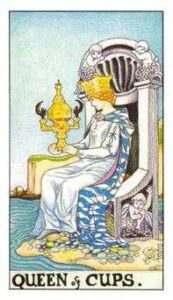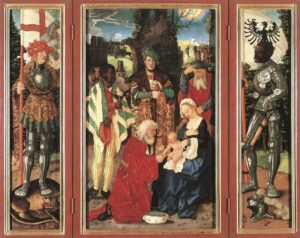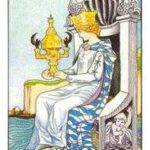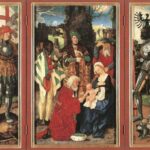There is a thinking in primordial images, in symbols which are older than the historical man, which are inborn in him from the earliest times, eternally living, outlasting all generations, still making up the groundwork of the human psyche. It is only possible to live the fullest life when we are in harmony with these symbols; wisdom is a return to them.
– Carl Jung

Living in a Culture That’s Lost Its Heart
“To learn how to fully live Eros makes a major contribution to the world around me, because this is a culture that’s lost its heart;




0 Responses
Thank you Jeanie. I am currently working on a section about the archetype of the Divine Feminine in my book…How she appears in our personal and collective dreams, visions, and synchronicities (like this post, for instance!). Thank you for so eloquently stating your ideas while providing an intriguing review of what sounds like my ‘kinda’ book; one that I’ve now added to my reading list.
Hugs,
Jenna
My pleasure, Jenna. You know how much I love this inner adventure into the depths. It’s so wonderful sharing the journey with you. I can’t wait to glean more wisdom from your book. More hugs, Jeanie
Thanks a lot for sharing !!!
Στάλθηκε από το iPhone μου
28 Απρ 2015, 7:01 π.μ., ο/η Matrignosis: A Blog About Inner Wisdom έγραψε:
>
>
You’re welcome, Anastasia. Thanks for stopping by.
Jean, If I understand you correctly, but “thinking symbolically” is what I try to do to understand the message of biblical stories. To me moving away from the literal is vital to that task. Thank you for this enlightening essay!.
Hi Rabbi Stephen. Yes, you pass on that wiser and fuller way of thinking in your symbolic interpretations of sacred stories. We’re so hungry for spiritual meaning. Unfortunately, head knowledge, reason, words, and literalism can’t change us because they don’t touch the heart, the storehouse of our deepest feelings and emotions and the source of compassion and love. The underlying symbolism in stories and dreams, however, has the power to change us by helping us feel our own fear, grief and pain. In so doing, we tap into that wellspring of living water, the key to our transformation. To re-quote Jung: “It is only possible to live the fullest life when we are in harmony with these symbols; wisdom is a return to them.” Thank you for writing.
Thank you Jeanie, this is an important addition to the wisdom of the archetypes, the Death Mother in this instance. A great loss to lose our connection to the world of symbolism as well as the ability to experience the divine within. Will we ever move away from literalness and rationality? I think so … there’s a zeitgeist about I think from one to the other, none too soon.
Hi, Susan. I see a movement toward more symbolic thinking as well. Films, television, feminism, computers and the internet all contribute to this resurgence. Of course, these all have negative aspects as well, but hopefully our increased communication and expanding collective consciousness can help us counteract them. By the way, I’m loving your daily blog posts about dreams and hate to see them end! Thank you for your contributions to our awareness of the value of symbolic thinking. Jeanie
The literalism of logos, I suppose, gives an inevitable hardening or simplification to our understandings, much the way that we see matter in our everyday lives as solids, liquids or gases, and forget or ignore the mystery of existence at the sub-atomic level, which is indeed where the heart is.
And so to my baby, poetry. Which opens the door to the heart through reminding us of the sub-atomic meanings and feelings attached to the word.
Always a pleasure to read you, Jeanie. Always a thrill where you take me.
Hey, Brian! Yaaay! Your comment came through without being blocked!! Thank goodness that’s fixed!
I love your way of expressing this issue of our obsession with literalism. It does, indeed, harden and simplify, leaving no room for complexity, feeling, or personal valuing: all the coolest and best stuff about our species with its profoundly felt yearnings toward all the things that make up a soul, like purpose, joy, creativity, intimacy, mystery and spiritual meaning! How could we as a species have thought we were functioning so well for so long with this serious oversight about the truth of our own makeup?
And yes, your baby, poetry, the highest and best manifestation of the sacred gift of words. For me, that place of creativity and imagination, that nous which molds words into poetry, is our portal to the Holy: “In the beginning was the Word, and the Word was with God, and the Word was God.” I don’t know about you, but my heart quickens at the depth of meaning in these timeless words about the sub-atomic realm.
Yes, indeed, always a pleasure, my friend.
Jeannie, I just read this “lesson” and found another piece of myself! Can’t wait to see you, soon I hope. Wish you could be here for Love Letters. We’re excited! Love, Vangie >
Hi Vangie, You found another piece of yourself! I love it when that happens!! I’m dying to know which piece. 🙂 Will you tell me when I see you this summer? Does it have anything to do with acting and the the symbolism found in good theater? I so wish I could see your play, but it’s not to be. I can’t wait to hear all about it. Love, Jeanie
Certainly made me want the book. I could use it for my essay looking at gender construction and symbolic implications in,The Odyssey, and Metamorphoses. I will look around town for it tomorrow. Your book looks good too. 😉
I think you’ll like it. Actually, mine should be of help too. It’s about the need to awaken and empower feminine values in ourselves and our culture and partner them with the masculine.
I would need them both today. hindsight is 20/20 lol They would sure be of use. I may cite the book anyways and you.
I’m grateful for your interest, whether or not you cite me! Thank you.
I just may. I will have to get both books in my library. 😀
Thank you, Jeanie. Sounds like a book I’ll love.
Recently, my mythology class studied an article by Toni Wolff on the four-fold feminine. We wove in the goddesses which Toni Wolff didn’t do with depth. Recently we made a collage of each of the four archetypes–mother, hetaira, amazon, and crone in positive and negative aspects. Two of our group members led this exercise, an art teacher and an art therapist, and created a great way to process the work. Negative Mother scared a few of the women, but we created the Negative Mother card in a circle of protection. The cards are remarkable. Lots of Medusa and Durga energy. Lots of blood red for life-giving and taking. Teeth, snakes, and tears.
What an amazing form of active imagination your group has found! This is bound to bring healing new insights into the lives of many of you. I think the Negative, or Death Mother’s time has come to be consciously dealt with, and you’ve provided a wonderful example of one way to do it. I’d love to hear about other ways people have found. Thank you, Elaine.
Thank you for your wise post, and for recommending the book; it’s now on my wish list. 🙂 I have to say that I’m struggling to understand the Death Mother, and hoping she will become clearer at some point. I recently listened to Marion Woodman talk about Death Mother via Marlene Schiwy’s interview (a DVD collection) and had trouble getting it straight. I’ll take it in small portions and let it simmer a bit each time. 🙂 As for Medusa, a few years ago, I read of a group that created a ritual for “reconnecting Medusa’s head to her body” with the conscious intention of healing … they made, if I recall correctly, a cloth body and a cloth head that they then stitched back together. It sounded quite powerful!
You’re welcome Darla. I know what you mean about not quite understanding the Death Mother. I think we’re only just beginning to see what she really is. We’ve lived in a society that scorns people who “blame” their parents for their unhappiness without accepting the fact that sometimes the parents are, indeed to blame. Because children who aren’t loved grow up to be adults who don’t love. We’re told to toughen up, get over it, act like an adult, stop feeling sorry for ourselves, be a warrior…..all that obsessive masculine stoicism that’s so killing to the tender soul. So we tell ourselves we’re fine because we don’t want to be ridiculed or judged by the harsh critics who wouldn’t know love if they saw it, but would see it as weakness. And parents go on being tough because they’re afraid not to be tough, afraid they’ll be accused of being “soft”, of “spoiling” their child, etc.
The authors say that the Death Mother is active in the parent who doesn’t know how to nurture her child, either outer or inner; who isn’t interested, doesn’t listen, doesn’t have time to give, won’t go out of her way, resents having to spend time, or is impatient or overly critical or judgmental. S/he doesn’t know how to cherish the child, give it warmth and understanding, etc. All this, because s/he was treated the same way as a child.
So all the best of the feminine qualities: the tender feeling, the trust and vulnerability, the patience and sweet receptivity, the gentle forgiveness, all this is frozen and replaced with indifference, perfectionism, demanding, controlling, or manipulating to get what I as a parent want from my child, instead of taking it upon myself to learn how to love and nourish my child. The authors give examples of people who have grown up with Death Mothers but have never really faced this fact. Because it’s a terrible thing to realize your parent didn’t know how to love you. So you keep trying to please and earn their love, and you’ll never be healed until you stop trying and accept your true hurt, do your grieving, etc.
Well, I didn’t know I was going to go on like that…….I guess my Shadow Orphan is showing up!!! I’ve seen and heard a lot of this in my life, although very little of it was aimed directly at me and my parents were definitely “good enough”. But that hard and tough attitude was very much a part of the Midwestern and Calvinistic “original sin” ethos in my parents generation and they couldn’t help but pass some of it on.
Anyway, I hope this helps a bit! Very cool about the Medusa reconnection ritual! I love the creative rituals people come up with when they finally get it that their soul is wounded and needs some serious attention!
Yes, this helps – thank you. Even uncomfortable as it may be at times, I do love this journey into greater consciousness. As it happens, after reading your posts, I read a post recommended by “Dreamwork with Toko-pa”: http://womboflight.com/2014/01/18/why-its-crucial-for-women-to-heal-the-mother-wound/ Would you see “Death Mother” as another aspect of, or the same as, the “Mother Wound”?
Hi Darla. You’re welcome. Yes, they’re both part of the same “syndrome.” It is a wounding that comes from growing up female in a culture that doesn’t fully support or value women or femininity. Thanks so much for providing this link. It’s a fabulous article that I highly recommend to anyone interested in this subject!
In Egyptian mythology, the Sky Goddess Nut swallows all living beings at their death and rebirths them into new life. This happens to the Sun, planets, and stars daily. To humans in a lifetime. To pharaohs, dogs, and ants. She’s one of the most interesting Death Mothers I’ve studied. The image of her elongated body arched across the sky is often painted on the ceiling of crypts or on the top of a casket. The Milky Way? All the souls in her body waiting to be reborn.
Thank you for mentioning this aspect of the Death Mother, Elaine. Like all archetypes, she too, is “bi-polar” by which Jung meant she contains opposite potentials: i.e. good and bad, dark and light, etc.
In Lunar Mythology, the Death Mother is respected as part of the natural cycle of life and her presence, like death in dreams, always symbolizes our hope for new life. As light is necessary for ongoing life, so is dark; as birth is a natural process, so is death, and so is rebirth. So our ability to respect her in this aspect represents our ability to live our lives fully and joyfully in the knowledge that it is a natural phase in the cycle of life.
However in Solar Mythology, (our present mindset), she is feared and repressed; hence we don’t know how to be grateful for the gift of life and tend to waste it in useless pursuits based on twisted values based on the obsession to escape Death, or at least, our awareness of it.
All so true. One of the things I love about Egyptian mythology is the mix of lunar and solar attributes of the ancient goddesses and gods. So you’d say the Egyptians had a Lunar Mythology? I agree. Do you know of a Jungian writer who has a book about Egyptian mythology? They certainly did honor Death. I love the unusual mix of gender relationships compared to European myth. There is a Solar Goddess as well as a Solar God and the power of the throne, the uroboros, is feminine. The Moon is associated with a God rather than a Goddess, and the Earth is masculine.
Thanks for this, Elaine. Yes, I would assume that Egyptian mythology was a blend of both, especially since, as you say, that they have both a Solar Goddess and God and a Lunar God. As Jung said, every archetype is bipolar (he meant that in terms of masculine/feminine too), which is why cultures tend to differ in their depictions of Deity. Ultimately it doesn’t matter which gender you assign because the point is not about the gender of our deities but about their wholeness and oneness! But until contemporary cultures realize this, we need to keep addressing this issue. I’m sorry but I don’t know of a Jungian who has written about Lunar Mythology. It would be fascinating, wouldn’t it?